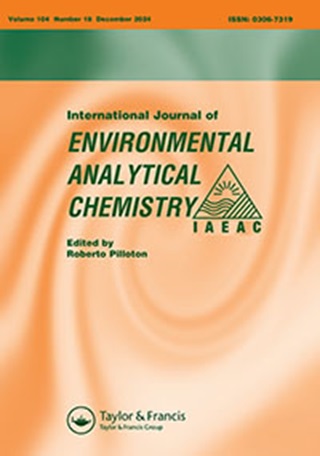One-pot/one-step synthesis of Bi 2 O 3 /ZnO/Pd nanocomposite for preconcentration and determination of some heavy metal ions in different samples
IF 2.5
4区 化学
Q3 CHEMISTRY, ANALYTICAL
International Journal of Environmental Analytical Chemistry
Pub Date : 2023-10-09
DOI:10.1080/03067319.2023.2262393
引用次数: 0
Abstract
ABSTRACTIn this contribution, a new green eco-friendly synthesised nanocomposite (Bi2O3/ZnO/Pd) was fabricated by one-pot/one-step method, using ultrasonic waves. The nanocomposite was used for pre-concentration of some heavy metals, i.e. cadmium (II), lead (II), and copper (II), exploiting ultrasound-assisted dispersive micro solid phase extraction (UA-D-μ-SPE) method, before their determination by flame atomic absorption spectroscopy (FAAS). The adsorbent synthesis was confirmed by XRD, SEM, BET, TEM, EDS, and TGA analyses. The central composite design (CCD) method was employed to optimise various parameters affecting the extraction of heavy metals. The effective parameters in the adsorption process, viz. the amount of adsorbent (16 mg), pH of the sample solution (6.2), and adsorption time (4 min), were optimised. The type and the concentration of eluting agent (HCl solution) was investigated as one parameter at a time. Impressive parameters in the desorption stage such as the volume and concentration of eluting solution (400 μL of 0.8 mol L−1 HCl) and desorption time (2.5 min) were optimised. In the best extraction conditions for cadmium (II), lead (II), and copper (II), the limits of detection (LODs) were 0.75, 2.1, and 0.90 ng mL−1; the limits of quantification (LOQs) were 2.5, 7.0, and 3.0 ng mL−1; the linear dynamic ranges (LDRs) were 2.5–100, 7.0–600, and 3.0–250 ng mL−1; preconcentration factors (PF) were 24.10, 25.20, and 25.39; and the relative standard deviations (RSDs%) were 3.7, 4.1, and 3.8 (n = 5), respectively. Additionally, the adsorbent had the ability to extract metals up to 8 times without a significant decrease in the extraction percentages. The adsorbent was successfully used in the determination of cadmium (II), lead (II), and copper (II) ions in different food, biological, cosmetic, and water samples.KEYWORDS: Bi2O3/ZnO/Pdheavy metal ionsUA-D-μ-SPEFAASfood sampleswater samples Disclosure statementNo potential conflict of interest was reported by the author(s).Data availability statementThe data will be made available upon request.Supplementary materialSupplemental data for this article can be accessed online at https://doi.org/10.1080/03067319.2023.2262393.Additional informationFundingWe want to take this opportunity to appreciate the support of Semnan University’s Chemistry Faculty for supporting this work [Grant 1671110].一锅一步法合成bi2o3 /ZnO/Pd纳米复合材料,用于不同样品中重金属离子的富集和测定
在此基础上,利用超声波,采用一锅一步法制备了一种绿色环保的纳米复合材料(Bi2O3/ZnO/Pd)。采用超声辅助分散微固相萃取(UA-D-μ-SPE)法对镉(II)、铅(II)、铜(II)等重金属进行预富集,然后采用火焰原子吸收光谱法(FAAS)进行测定。通过XRD、SEM、BET、TEM、EDS、TGA等分析证实了吸附剂的合成。采用中心复合设计(CCD)方法对影响重金属提取的各参数进行优化。优化了吸附剂用量(16 mg)、样品溶液pH(6.2)、吸附时间(4 min)等吸附过程的有效参数。同时考察了洗脱剂(盐酸溶液)的种类和浓度。优化了洗脱液的体积、浓度(400 μL / 0.8 mol L−1 HCl)和洗脱时间(2.5 min)。在最佳提取条件下,镉(II)、铅(II)和铜(II)的检出限(lod)分别为0.75、2.1和0.90 ng mL−1;定量限(loq)分别为2.5、7.0和3.0 ng mL−1;线性动态范围(ldr)分别为2.5 ~ 100、7.0 ~ 600和3.0 ~ 250 ng mL−1;预浓缩因子(PF)分别为24.10、25.20和25.39;相对标准偏差(rsd %)分别为3.7、4.1和3.8 (n = 5)。此外,吸附剂有能力提取金属高达8次而不显着降低提取率。该吸附剂成功地用于食品、生物、化妆品和水样中镉(II)、铅(II)和铜(II)离子的测定。关键词:Bi2O3/ZnO/ pd重金属离子sua - d -μ- spefaas食品样品水样披露声明作者未报告潜在利益冲突。数据可用性声明数据可应要求提供。补充材料本文的补充数据可以在https://doi.org/10.1080/03067319.2023.2262393.Additional上获得。我们想借此机会感谢Semnan大学化学系对这项工作的支持[Grant 1671110]。
本文章由计算机程序翻译,如有差异,请以英文原文为准。
求助全文
约1分钟内获得全文
求助全文
来源期刊
CiteScore
5.90
自引率
7.70%
发文量
373
审稿时长
4.4 months
期刊介绍:
International Journal of Environmental Analytical Chemistry comprises original research on all aspects of analytical work related to environmental problems. This includes analysis of organic, inorganic and radioactive pollutants in air, water, sediments and biota; and determination of harmful substances, including analytical methods for the investigation of chemical or metabolic breakdown patterns in the environment and in biological samples.
The journal also covers the development of new analytical methods or improvement of existing ones useful for the control and investigation of pollutants or trace amounts of naturally occurring active chemicals in all environmental compartments. Development, modification and automation of instruments and techniques with potential in environment sciences are also part of the journal.
Case studies are also considered, particularly for areas where information is scarce or lacking, providing that reported data is significant and representative, either spatially or temporally, and quality assured. Owing to the interdisciplinary nature of this journal, it will also include topics of interest to researchers in the fields of medical science (health sciences), toxicology, forensic sciences, oceanography, food sciences, biological sciences and other fields that, in one way or another, contribute to the knowledge of our environment and have to make use of analytical chemistry for this purpose.

 求助内容:
求助内容: 应助结果提醒方式:
应助结果提醒方式:


